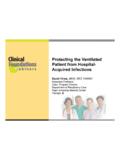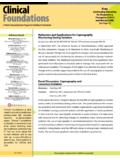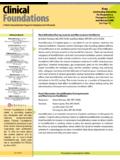Transcription of Free Foundations
1 Clinical Foundations is dedicated to providing healthcare professionals with clinically relevant, evidence-based topics. Clinical Foundations is pleased to announce a webinar series featuring leading healthcare professionals. To find out more about the current webinar and to register, go to Each webinar is accred-ited for CRCEs and Branson, MS, RRT, FAARC Professor of Surgery, EmeritusUniversity of Cincinnati College of MedicineCincinnati, OHKathleen Deakins, MS, RRT, NPSM anager, Women s Children s respiratory CareUniversity Hospital, Rainbow Babies & ChildrenCleveland, OHWilliam Galvin, MSEd, RRT, CPFT, AE-C, FAARCP rogram Director, respiratory Care ProgramGwynedd Mercy College, Gwynedd Valley, Haas, MS, RRT, FAARCE ducational & Research CoordinatorUniversity Hospitals and Health CentersAnn Arbor, MIRichard Kallet, MSc, RRT.
2 FAARC Director of Quality Assurance, respiratory Care ServicesUSCF General HospitalSan Francisco, CANeil MacIntyre, MD, FAARC Medical Director of respiratory Services Duke University Medical Center Durham, NCTim Op t Holt, EdD, RRT, AE-C, FAARC Professor, Department of respiratory Care and Cardiopulmonary Sciences University of Southern Alabama Mobile, ALHelen Sorenson, MA, RRT, FAARC Assistant Professor, Dept. of respiratory Care University of Texas Health Sciences Center San Antonio, TXW ebinarsThis program is sponsored by Teleflex IncorporatedMC- 0 059 0 4 ClinicalFoundationsA Patient-focused Education Program for Healthcare ProfessionalsFree Continuing Education for respiratory Therapistsand NursesSee Page 12 Advisory BoardFaculty Disclosures:Matthew S.
3 Pavlichko, MS, RRT-NPS, Kathleen Deakins, RRT-NPS, FAARC, Rob DiBlasi, RRT-NPS, FAARC, Keith Hirst, MS, RRT-ACCS, RRT-NPS, AE-C, Lee Williford, RRT-NPS, RCP each disclosed no conflicts of interest associated with this publicationPyramid of Care: Pediatric EditionBy Matthew S. Pavlichko, MS, RRT, RRT-NPSAs our healthcare landscape changes, reimbursement difficulties, cost containment, readmission penalties, and the role and scope of the future respiratory therapist is up for debate. Identifying and providing value to the patient and the organization is imperative for any respiratory care de-partment, large or small. Our value is never more evident than during a respiratory emergency, most importantly, of a pediatric patient.
4 This article will review the historical need for winter pediatric preparations in respiratory care as well as the treatment theory called the respiratory Pyramid of Care: Pediatric Edition. Panel Discussion: NIV and HFNC for Neonates and Pediatric Patients Moderator: Kathleen Deakins, RRT-NPS FAARC Panelists: Rob DiBlasi, RRT-NPS Lee Williford, RRT-NPS, RCP Keith Hirst, MS, RRT-ACCS, RRT-NPS, AE-CSeveral methods are used in pediatric and infant populations to ensure adequate breathing and sufficient levels of blood oxygen. These meth-ods are placed along a continuum or pyramid of utility. Two of the most popular methods are: High-Flow nasal cannula (HFNC) which adds heat and humidity to the air flow to create a level of comfort that other oxy-gen devices are lacking, and continuous positive pressure airway pres-sure (CPAP) devices, which is a noninvasive method of delivering air to the lungs under mild pressure.
5 In this panel discussion, three experts dis-cuss the pros and cons of HFNC as well as CPAP, and when and how they should be used. Clinical our healthcare landscape changes, reimbursement diffi-culties, cost containment, read-mission penalties, and the role and scope of the future respiratory thera-pist is up for debate. Identifying and pro-viding value to the patient and the orga-nization is imperative for any respiratory care department, large or small. Our value is never more evident than during a respi-ratory emergency, most importantly, of a pediatric patient. This article will review the historical need for winter pediatric preparations in respiratory care as well as the treatment theory called the Respira-tory Pyramid of Care: Pediatric Edition.
6 The Emergency Medicine Network has recorded that there are 5,273 EDs in the However, of those 5,273 emer-gency departments, only 220 reside in a children s hospital (CHA).2 These statis-tics lead to the assumption that most pedi-atric ED visits are performed outside the walls of a children s hospital. Chamberlain and colleagues described the scope of this phenomenon in 2013,3 when they report-ed that up to 90% of all pediatric emergen-cy cases did not receive care at a pediatric specialty hospital. In addition, according to the Agency for Healthcare Research and Quality (AHRQ),4 only 5% of pedi-atric ED visits result in admission to the same hospital.
7 The AHRQ also reported that in 2015, the most common reason for pediatric patients to visit the ED was for respiratory disorders, especially during winter The ED is not the only location that deals with respiratory emergencies. Many inpatient pediatric units and neonatal in-tensive care nurseries across the country reside outside the wall of a children s hos-pital. This phenomenon places enormous pressure to deliver high quality care in a low-volume, high-risk patient population in settings where the least amount of ex-perience, knowledge, and resources are available. Is pediatric respiratory emer-gency truly low-volume ?
8 This module will describe the respiratory Pyramid of Care within the scope of pediatrics. Its purpose, is to provide comprehensive in-sight into the respiratory treatment strat-egy of the sick child and to better prepare clinicians for the child who will inevitably is the Pyramid of Care?The Council for Advances in Respi-ratory Therapy developed the theory of Navigating the respiratory Pyramid of Care in 2010. Led by David Vines, PhD, RRT, FAARC, the council (comprised of expert respiratory care thought leaders from across the country) developed an extensive, peer-reviewed educational cur-riculum to create a comprehensive under-standing of oxygen therapy and ventila-tory This curriculum describes the treatment selection strategy for adult patients with respiratory compromise, as well as how to navigate the severity of their illness, from worsening progression to weaning.
9 Although, initially created to care for the adult patient, the Pyramid of Care translates well to the pediatric pa-tient population.(Figure 1)The pyramid s shape is the most im-portant concept. The foundation of the pyramid serves the largest population and has the least complexity; , patients on room air. As one moves up the pyramid, one shifts in treatments that are higher cost and complexity but are necessary for a smaller number of patients. When pa-tients conditions worsen, they advance up the pyramid, but when they improve, they are weaned down the pyramid. Each treatment meets the patient s needs, but each has nuances that can serve as a con-duit or a barrier to care.
10 Each is described in more in depth that Resolve Hypoxemia/HypoxiaWhen the body s partial pressure of arterial oxygen (PaO2) falls below normal levels, hypoxemia is present. Hypoxemia can be caused by hypoventilation, shunt-ing, diffusion defects, abnormal hemoglo-bin, anemia, and/or poor perfusion. Signs and symptoms include increased work of breathing (WOB), tachypnea, shortness of breath, tachycardia, poor perfusion, and potential neurological Hy-poxemia can occur during severe trauma, shock, cyanide and carbon monoxide poi-soning, cardiac arrest, and perioperative emergencies. In 2016, The World Health Organiza-tion (WHO) created the Oxygen Therapy Pyramid of Care: Pediatric EditionBy Matthew S.









